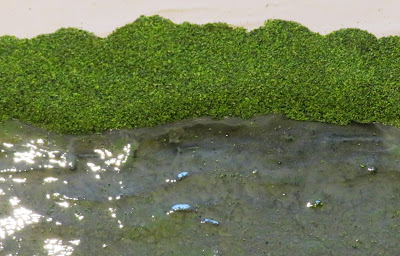Having varnished the water, I then dealt with the water's edge. I looked at photographs of the parts of the Mucking Flats and Fobbing Marsh where they meet the River Thames, and they showed that it is basically grassy with some low bushes. I therefore decided to use a similar method to the one that I used to create my marsh.
I carefully applied PVA glue where the water of the River Thames met the land and sprinkled a layer of green flock (a mixture of K&M Trees No.1 Grass Green and K&M Trees No.7 Dark Green) over it. I then let that thoroughly dry before using a desk vacuum cleaner to remove the excess flock. In order to ensure that the coverage was as thick and regular as possible, I repeated the process for a second time.
To create the tussocks of grass and low bushes, I decided to experiment with making them before I applied them to my layout baseboard. The method I used was as follows:
- I blobbed small amounts of PVA glue on two separate thin plastic pieces of plastic.
- The one I used for the tussocks of grass had four rows of six blobs, over which I scattered Noch Spring Meadow (50210) static grass.
- The one I used for the low bushes had three rows of five slightly larger blobs, over which I scattered what was left of the green foam that I made when I created the marsh areas on my layout.
- Once the PVA glue was dried, I applied a second blob of PVA glue to each of my existing grassy tussocks and low bushes and covered each with another layer of static grass or foam.
- Once the PVA glue was dried, I applied a mixture of 50% PVA and 50% water (with a tiny drop of washing up liquid added to it) on every clump of foam, using my trusty syringe to do this. This had the effect of hardening the foam.
The end results looked like this:
Tussocks of grass.
Low bushes.
I have made more than I actually need but as the tussocks of grass and clumps of bracken remain stuck to the plastic sheet, I can store them for future use on this or future projects.
I then glued a number of tussocks of grass and low bushes to the area next to the River Thames using PVA. Once the PVA had dried I then applied a mixture of 50% PVA and 50% water to the whole area, and once that had dried it looked like this:
I'm not quite sure what part of my model railway I will deal with next, but I suspect that I might want to 'firm up' the actual track layout before I add any more terrain features.





























.jpeg)










BOB,
ReplyDeleteAll looking very good- your model planning has worked well. Cheers. KEV.
Kev Robertson (Kev),
DeleteCheers! The layout is slowly beginning to take shape. I just wish that I could spend more time working on it.
All the best,
Bob
It looks enticing; I'd want to swim there. Great work!
ReplyDeleteQuantrilltoy,
DeleteI wouldn’t recommend swimming in this part of the River Thames! It’s a bit too close to the (now decommissioned) sewage pumping stations for the whole of London.
All the best,
Bob
Very effective Bob and a neat idea to make the tufts seperately, which I might have to have a go at:).
ReplyDeleteSteve J.,
DeleteYou can buy readymade tufts but making my own was an interesting experiment.
All the best,
Bob
The river has turned out really well and both parts have been a great tutorial, looking forward to your next post on this project.
ReplyDeleteDonnie McGibbon,
DeleteI’m please to read that you’ve enjoyed my blog posts and have found them to be useful.
All the best,
Bob
Looks great! Your layout is coming along very nicely!
ReplyDeleteMark Cordone,
DeleteCheers! Things are gradually progressing and I hope to get it finished by the end of this month.
All the best,
Bob
Looks very riverine, Bob.
ReplyDeleteArchduke Piccolo,
DeleteCheers! I’m rather pleased with the way it’s turned out.
All the best,
Bob
The river and riverbank look very effective.
ReplyDeleteMaudlin Jack Tar,
DeleteLooking at photographs and copying what I saw helped me to make it look reasonably realistic.
All the best,
Bob
Nicely done, Bob. 👍🏼
ReplyDeleteMartin S.,
DeleteCheers! There’s more to come soon.
All the best,
Bob